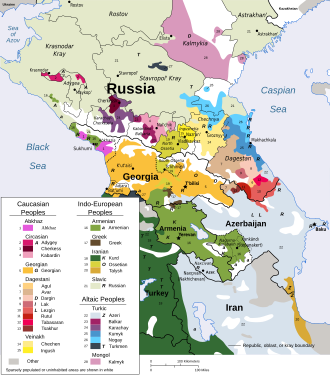| Russo-Caucasian conflict | |||||||||
|---|---|---|---|---|---|---|---|---|---|
 Ethnic map of Caucasus | |||||||||
| |||||||||
| Belligerents | |||||||||
| Caucasian states, militants and allied groups |
| ||||||||
|
| ||||||||
The Russo-Caucasian conflict is a protracted ethnic and political struggle between various North Caucasian peoples and Russian, Soviet, and Imperial Russian authorities. This conflict dates back to the 16th century, as Russian forces sought to expand southward. Various Caucasian groups, including Abazins, Abkhazians, Circassians, Chechens, Ingush, Karachay-Balkars, Ossetians and Dagestanis (various Dagestani nations), resisted Russian control through both armed and diplomatic means. The conflict’s modern phase intensified following the Soviet Union’s collapse in 1991, with separatist aspirations and resistance movements that continued to face suppression into the 21st century.[3][4][5]
- ^ "Eurasia Overview". Patterns of Global Terrorism: 1999. Federation of American Scientists. Archived from the original on 26 April 2009.
Georgia also faced spillover violence from the Chechen conflict...
- ^ Gordon, Michael R. (17 November 1999). "Georgia Trying Anxiously to Stay Out of Chechen War". The New York Times.
- ^ "The North Caucasus Conflict and its Implications for Russia". www.wilsoncenter.org. Retrieved 2024-10-29.
- ^ Redactie (2024-08-14). "Why the violence in the North Caucasus should worry Russia". RAAM (in Dutch). Retrieved 2024-10-29.
- ^ "Did You Know...Russia's North Caucasus | USCIRF". www.uscirf.gov.
© MMXXIII Rich X Search. We shall prevail. All rights reserved. Rich X Search
